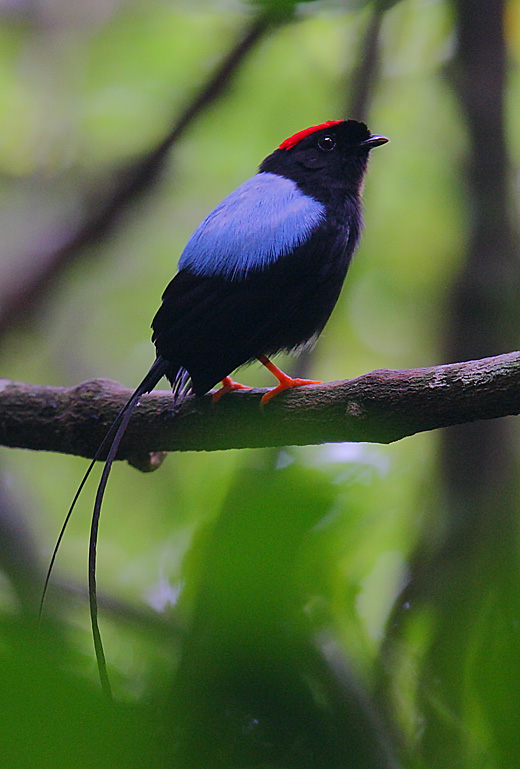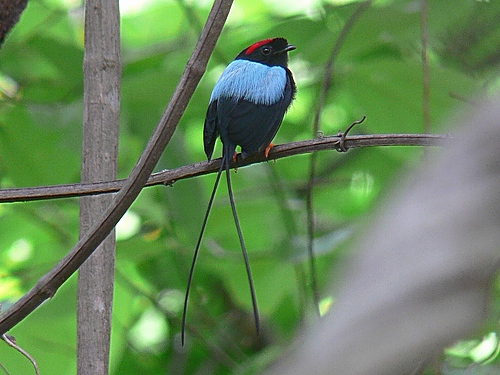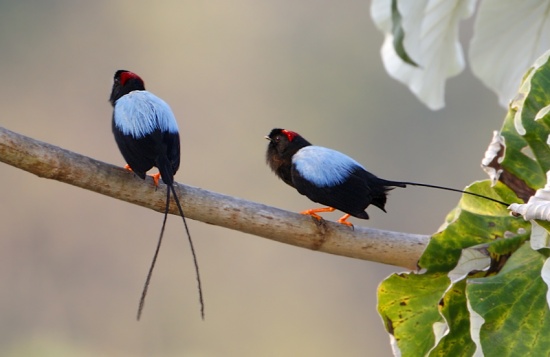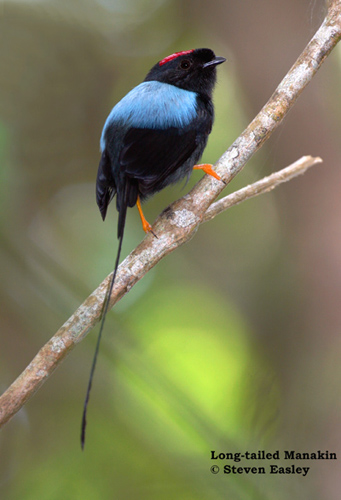
Chiroxiphia linearis
SUBFAMILY
Piprinae
TAXONOMY
Pipra linearis Bonaparte, 1838, Mexico = Santa Efigenia, Oaxaca.
OTHER COMMON NAMES
French: Manakin fastueux; German: Langschwanzpipra; Spanish:
Saltarнn Toledo, Saltarнn de Cola Larga.
PHYSICAL CHARACTERISTICS
Sexes differ. Female’s length is 5.5 in (14 cm), including 1 in
(2.5 cm), elongated, central tail feathers. Male’s length is
8.5–10.5 in (21.5–26.5 cm), including 3.9–5.9 in (10–15 cm),
elongated, central tail feathers. Weight is 0.7 oz (19 g). The
male is mostly black with an azure blue back, a red crown with
a rear projecting crest, and long, central tail feathers. Females
are olive-green. Distinctive orange legs and feet.
DISTRIBUTION
Southern Mexico to Costa Rica.
HABITAT
Open vine tangles and thick undergrowth of dry or humid forest,
secondary forest and plantation borders, and borders of
mangroves swamps.
BEHAVIOR
Mercedes S. Foster conducted classic observations of the longtailed
manakin. In the advertising call, male pairs or trios synchronously
repeat, “To-lay-do,” from which their Spanish
name has been derived. In the Up-Down Dance, males alternately
make fluttering jumps straight upward into the air. In
the Cartwheel Dance, each male in turn flutters up and backward
in a vertical circle to land on the spot previously occupied
by his dance partner. As many as 100 jumps may be completed
per cartwheel sequence. The dominant male, who gets all copulations,
finally ends the cooperative display and dismisses his
dance partner with a single piercing note pweet!.
FEEDING ECOLOGY AND DIET
Uses sallying flight to pluck small fruits from tropical, evergreen
understory trees like Ardisia revoluta (Myrsinaceae), as
well as from shade-intolerant secondary growth trees such as
Cecropia peltata.
REPRODUCTIVE BIOLOGY
Following copulation, the female leaves to build the nest, incubate
eggs, and raise the young on her own. The nest is a shallow
cup of fibers, mosses, grasses, and dry leaves, attached by
its rim and suspended from horizontal forks in small trees, approximately
27 ft (8 m) above the ground. The nest is not
placed with any obvious connection to the lek. One, or usually
two, buffy eggs with heavy brown spotting are laid. Fruit is included
in the diet of the offspring.
CONSERVATION STATUS
Not threatened. Common in its preferred habitat; abundant in
some areas.
SIGNIFICANCE TO HUMANS
Eco-tourists and birdwatchers enjoy seeing the males.
Photo Gallery of - Long-tailed manakin




 Animalia Life
Animalia Life